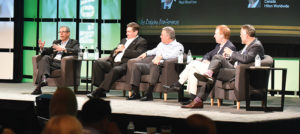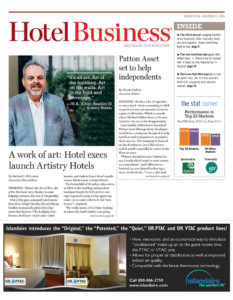PHOENIX—Amid talk of headwinds and tailwinds blowing over the lodging industry, the overall tone of conversation remained positive at The Lodging Conference this year.
The largely “steady-as-she-goes” attitude emanating from the majority of executives in attendance was buoyed by a record-breaking crowd of some 1,800 at the 22nd annual event held here at the Arizona Biltmore, A Waldorf Astoria Resort, with a notable number of first-timers joining the traditional ranks of hospitality-universe movers and shakers.
“This capacity crowd tells me this break for our lodging cycles has a lot of road left to go,” said Harry Javer, producer and cofounder of the conference, riffing off its theme of “Enjoy the Ride.”
From Think Tank sessions to networking receptions and the Frank Lloyd Wright-inspired hotel’s jam-packed public spaces, the outlook by hospitality and financial executives heading into 2017 still sees a lot of runway ahead to get deals done and be profitable.
However, Javer noted, how good business is depends on the measuring stick being used.
“If we compare this year to 2015, it’s kind of a tough measurement since 2015 was such an outstanding year in so many different ways, with so many records broken in this industry. But if we look more historically, then 2016 will shape up to be another great year for the industry. Certainly, deal volume is down, capital markets have had their issues, but fundamentals remain solid,” he said.
Looking back at the industry’s performance ups and downs over the past decade, STR’s Stephen Hennis noted 2016 is now enjoying “a record level of occupancy and a record level of average daily rate”; even though the latter is slowing, it’s still showing growth. Similarly, record-level RevPAR has clocked 78 months of growth through August, with month’s end September expected to ratchet that number to 79 when assessed.
“Profits are also at a near-record level… We’re expecting 2016 to be the most-profitable year in the hotel industry ever,” said Hennis.
One concern swirling within the chatter at TLC was supply growth and its potential impact on the industry. Hennis noted, however, historically “supply hasn’t caused a downturn. It might be impacting markets here and there—Houston, New York—but in itself, supply is not really the issue that would cause us to have a massive downturn. It’s just the timing of that supply that we’ve seen over time that’s really been an issue.” The question, he added, is what happens when supply begins outpacing demand.

A panel led by Katherine Lugar (center), American Hotel & Lodging Association (AH&LA), showcased the observations of, left to right: Naveen Kakarla, HHM; Jim Amorosia, G6 Hospitality, LLC; Thomas Magnuson, Magnuson Hotels; Kirk Kinsell, Loews Hotels; David Kong, Best Western Hotels and Resorts; and Lance Shaner, Shaner Hotels.
In the trailing 12-month period, he said supply growth has been up 1.4%, with STR projecting at year’s end 1.6% growth. “Still,” said Hennis, “The all-time, compounded annual growth rate for supply growth is 1.9%, and we’re not expected to hit that until next year. So, still relatively low supply growth when you look at it in the big picture.”
Both Hennis and Mark Woodworth, senior managing director, CBRE Hotels-Americas Research, were optimistic about the state of the economy. “Expectations are economic growth for next year should be superior to what we see this year,” said Woodworth.
The CBRE executive touched on industry-disrupter Airbnb, noting the space-sharing enterprise within the 12-month period ending in June more than doubled its number of units in the United States, up 110%. “The number of units that were actually rented during that period also doubled; $4.7 billion in revenue, which was more than double. So Airbnb continues to grow and becomes an even more-important, relevant factor in understanding the future of our industry, specifically as it relates to traditional hotels.”
On the transactions side, Aran Ryan, managing director and senior partner for HVS, said in first-half 2016, transactions volume in the U.S. was down 52% with “price per key down 15% in the transactions that are left. That’s after we reached a historic peak in 2015 by a pretty wide margin.” He noted drivers behind that include a change in lender makeup and the investor mix, with REITs and institutional investors moving to the sidelines, a pull back in CMBS activity, and a widening of the buy-sell gap.
Additionally, portfolio sales dropped from $6 billion last year to $1 billion thus far in 2016, a 77% decline, signaling inactivity by REITs and institutional investors that, to a large degree, usually play in the space, Ryan noted.
“What we’ve seen is an evaporation of portfolio sales,” he observed. Individual transactions descended 37%.
“That really shows us that, so far, this year, we’ve had this dramatic dislocation between the transactions market and what’s going on in underlying hotel fundamentals,” he said.
Ryan added that by 2018,“We expect to see the first slight decline in hotel values since the recession. But once we move past those investment factors, once we’ve loosened those things up in 2019 and we still see underlying RevPAR growth, we should see a pop; a strong recovery from what we saw in 2018… We’re soft-landing here and we expect the next piece of the hotel cycle to start in 2019.”

An executive panel focused on development included Joel Eisemann, IHG; Phil Hugh, Red Roof Inn; Eric Jacobs, Marriott International; David Pepper, Choice Hotels International; and Matt Wehling, Hilton Worldwide.
Positive sentiments were echoed across the general sessions that gave industry leaders opportunities to present their views, with a quip by lodging veteran Tom Corcoran Jr., board chairman of lodging REIT FelCor Lodging Trust, Inc., likely giving the audience the touchstone it was looking for to describe the industry currently.
“I think we’re in a phase of the industry right now, where we’ve got good growth above GDP, the industry seems to have demand, so I believe it’s going to be fairly ‘steady Eddie,’” he said.
Corcoran was part of the opening panel led by Don Landry, owner of Top Ten Hospitality Advisors, that included: Jim Abrahamson, CEO, Interstate Hotels & Resorts; Geoff Ballotti, president/CEO, Wyndham Hotel Group; Roger Bloss, president/CEO, Vantage Hotels; Eric Danziger, CEO, Trump Hotels; and Bruce Patel, 2016 chairman, Asian American Hotel Owners Association (AAHOA).
Danziger, who launched Trump Hotels’ new brand, Scion, at the conference, addressed minimum-wage legislation and reform, terming it a “course correction of business; all businesses. Somehow, we always cry wolf or ‘Oh, my God,’ but somehow the industry finds a way to manage through that [increases], as is our responsibility… Wages will go up, and by the way, they should.”
The CEO indicated increased wages would allow for the attraction of better talent within the industry.
Abrahamson dismissed the idea that Chinese investment into the U.S. lodging space was only a trend. “We have close to 450 hotels. Of that, 40 hotels now are owned by Chinese owners and, in every transaction that we’re involved in, there’s at least one Chinese buyer within that market. They’re growing exceptionally fast. We’re working with a Chinese owner right now and they’re buying two hotels from a REIT in New York City. It is definitely not a trend. It is here. And they are good buyers and long-term holders.”
In smaller markets, Bloss saw continued strong performance, particularly for the select-service segment. “It’s still a street-corner business…we’re seeing a lot of new construction. You’re going to seeing local money [going into]properties being built,” he said.
Patel noted part of the continued robustness of hotels opening stemmed from “debt being cheap” and in some cases, non-traditional financing, such as overseas money coming in the form of EB-5.
“Conventional financing is still where it’s at,” he offered, noting working through a local or regional bank presents the most likely scenario for getting a project financed.
Ballotti came back to the bottom line and the end-user, the guest, noting efforts by hoteliers along any variety of avenues need to translate back. “Loyalty has never been more important than it is today.”
From his perspective, Javer cited some “powerful trends” that would help keep the industry’s engine running in the months ahead.

Kirk Kinsell, Loews Hotels, and Joori Jeon, AH&LA and AH&LEF, flank TLC’s Harry Javer following a presentation of an award for his work as chairman/AH&LEF Fund Development Committee.
Among them is the continued increase in travel, driven by more free time for baby boomers as they retire; the attitude of millennials to acquire experiences rather than big-ticket items; a rise in household incomes and an increased amount of disposable income being put toward travel; technology and globalization helping to “shrink” the world via the Internet and cell phones; and—airport lines aside—a greater convenience to travel, particularly via automobile, e.g., car sharing, cheaper gas prices.
“These are all very good trends that will keep people traveling,” said Javer, who in the same breath indicated the rosy outlook had some clouds.
“To begin with, just because more people are traveling doesn’t necessarily mean they’re going to stay in hotels. We have competition from home-sharing services like Airbnb; that’s not going away. We have a love/hate relationship with the OTAs. We have social media sites that we constantly have to monitor for bad reviews. These are some of the challenges of technology.”
On the operations side, the executive pointed to the costs of doing business. “It’s getting more expensive to run a hotel: labor costs are going up, construction costs are going up, the cost of capital will definitely be going up,” he said.
Also in the obstacle mix are cyber-terrorism, the threat of terrorism and uncertainty.
“But despite these obstacles, remember: 2015 was the second most profitable year ever for this industry and 2016 will not be far behind,” said Javer.
Check out our video interviews at video.hotelbusiness.com


